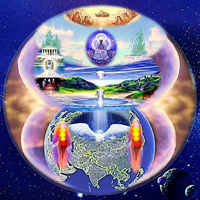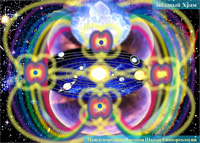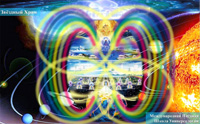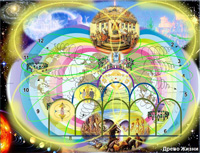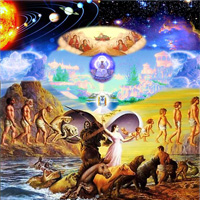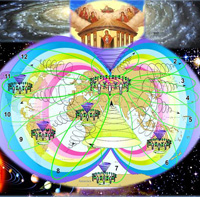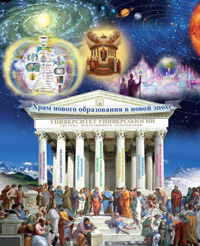Calendar
| Mo | Tu | We | Th | Fr | Sa | Su |
|---|---|---|---|---|---|---|
| 1 | 2 | 3 | 4 | |||
| 5 | 6 | 7 | 8 | 9 | 10 | 11 |
| 12 | 13 | 14 | 15 | 16 | 17 | 18 |
| 19 | 20 | 21 | 22 | 23 | 24 | 25 |
| 26 | 27 | 28 | 29 | 30 | 31 |
Moon Phase

Banners
| The law of succession and similarity |
|
(The law of denying denial)
Pesina Tatyana I., candidate of technical sciences.
Development never begins with a “clean slate”, it does not start “from scratch”; succession manifests in everything. Succession is one of the central categories of dialectics. It is a preeminent link between the new and the old in the process of development when the new replaces the old, something new retains some elements of the old, it is based on them as on the baseline, based on which the new continues its development. Albert Einstein said, “If I was able to see further, that is only because I stood on the shoulders of giants.” Walt Whitman, an American poet said, “The law of succession is the law of laws, for what is the present, it is a twig sprouting from the past into the future.” A hologram is a good illustration of the principle of similarity: an image can be pictured as a whole by looking at a part of a holographic image. In the same fashion, the whole world is built on the principle of a hologram: at any point of the universe, there is information about it as a whole. Like a hologram, every cell of the body contains the information about the structure and development of the whole body. Medicine has long been using the idea that the structure of the entire human body is projected on an ear, a foot, and then on a finger and a phalanx. Thus, all the organs and systems have projections on the parts of the body in the form of specific zones and points on a hand. Knowing these points of correspondence and acting upon them, a person can very effectively provide emergency assistance to specific organs and systems all over the body. The principles of succession and similarity are reflected in the Bible: “Whatever is above is below”, “whatever is in heaven is on the earth”, “God had a plan to create a world similar to himself.” Similarity means having some of the same features in different objects. It plays a major role in the learning process, because only similar things can be compared. Moving from the known to the unknown is possible only if the unrecognized ideas contain something that is similar to the known ones, thereby, partially known. The famous inscription on the walls of the Temple of Apollo at Delphi says, “Learn thyself.” In other words, learn yourself, and you will know the whole world. Universology demonstrates the fact that universal laws are a unifying element of all the living systems. Therefore, today it will not be an exaggeration to say: “Learn the universal laws, and you will know what the whole world contains and how it develops.” It is the knowledge and application of the organization and development of the universal laws of the world which makes scientific prognosis possible. The essence of the law of succession and likeness is the following. Any system in its development is based on the experience and previous achievements. From the start, each successive stage incorporates the previous experience and quickly repeats it in a small cycle, which is the essence of succession. Then the system should accumulate new experience and synthesize it with the previous to achieve a qualitatively new state and go on to the next level. At the same time, on a new level of development, a scheme of accumulating experience is repeated. In other words, at all levels of systemic relations, the universal laws of development are always repeated in three dimensions: in space, time, and energy exchange; this is how the essence of similarity is manifested through the repetition of the universal laws. In space, the sevenfold structural organization and the triplicity of causal relations are repeated. In time, two phases and twelve stages of the cycle of formation of the system are repeated. In the process of energy exchange, the systems’ attempt to integrate and increase energy consumption is repeated. It is important to examine the succession and similarity of seven levels of structural organization. Any system develops on three levels: - structuralizing or psychophysical - cooperation or the sensitive - management or mental-conceptual This is how the system of sevenfold relations works: during the interaction of a triple object and triple subject, seven levels of systemic relations occur when the fourth, transitional, level is set. Each of the seven levels has its own triad, the trinity of causal relationships, and its own sevenfold, seven sublevels in each level. This process goes on infinitely, both inwardly and outwardly. For example, each person is a super-system for his or her own body, something more powerful, something that links everything and is not fully recognized by the cells. At the same time, each person is a cell of a universal organism. In turn, humanity, the fourth estate of nature, is a larger system for the three prehistoric estates, mineral, vegetable, animal, and, at the same time, humanity is a smaller system for its three higher hierarchies. Together, the seven estates of nature constitute the planetary body. Our planet, in turn, is a part of the solar system, its fourth energy level, the heart of the solar body. The solar system, in turn, is only the physical level of our Galaxy, etc. In addition, each time a sevenfold structure is built, as soon as the system is formed, and the reason recognized, the whole system becomes a consequence, there appears an access to the super system, and a new reason of learning opens up. To sum up, all life systems have a unified scheme of forming a structure. There are always seven levels of the structural organization and the triplicity of causal relations. Therefore, the law of succession and similarity, contained in the formation of the systemic of relations is also called the law of seven triads. Similarly, succession and similarity manifest in the gradual formation in time. Just as the formation of a sevenfold structure corresponds to the cycle of the system development, each sub-cycle corresponds to each sublevel and a set of twelve sub-cycles as the twelve stages of development in two phases ensures the completeness of the cycle of the system development and creates conditions for a transition to the super system, or a larger cycle. To read about the repetition of the universal laws of energy exchange which imply the systems’ effort to unite and increase the amount of energy, see the law of conservation of energy in the cause-effect relationship. It is important to examine the manifestation of the law of succession and similarity in various areas. 1. In philosophy The law of denying denial is one of the basic laws of dialectics. This law expresses the succession of the connection of the new with the old, the recurrence at the highest stage of development of some of the properties of the lower stage and proves the progressive character of development. In dialectics, the category of “denial” is the transformation of one object into another, while “destroying” the first. Yet, this is the kind of “destruction”, which frees room for further development and, at the same time, acts as connection with the retention of all the positive content of the stages that have been experienced [16]. In describing the motion of an absolute idea, instead of using the term “denial”, Hegel used the term “withdrawal”, which denotes not only destruction, but also preservation of the entire contents of previous development in the processed, synthesized form. Succession is one of the criteria for the real path of development. Succession is particularly important for a proper understanding of the laws of science and art. Understanding succession helps to eliminate distortions and avoid such extremes as nihilistic negation of cultural heritage on the one hand, and on the other conservatism and blind adherence to traditions of the past, including its dogmas and stereotypes. The biogenetic law of E. Haeckel about repetition of phylogeny in ontogeny: in the process of its individual development (ontogeny), each organism repeats the key features and characteristics of the stages through which its ancestors passed in the course of evolution (phylogeny). The principle of succession reflects in the principle of historicism, which is one of the principles of learning, thereby considering any phenomenon as a product of specific historical development. Succession reflects in the dialectic struggle between the new and the old: - the new is begotten in the depths of the old and based on it - in the beginning, the new is weaker than the old, but it absorbs all the positive things contained in the old, grows, and gains strength in the struggle with the old - as a result, despite the resistance of the old, the new overtakes, because it contains a powerful development potential - at the same time, the new becomes the old and must give way to the new 2. In a human body It is known that a person’s energy system has seven energy levels, and each of them is structured in the same way as that of the system as a whole. Each energy level is similar to the entire system. For example, the fourth level is the “heart” of the entire system, yet each sublevel has its own “heart”, including the second, a sensitive. When a person makes a choice between the personal and the common good in favor of the common, when the choice manifests in life at all levels of relationships, when the fourth sublevel of each energy level is brought to perfection, only then can people talk about an “open heart” which, unfortunately, is often confused with the sentimentality of the human sensitive level. Triplicity of the three main stages of formation manifests in the structure of a cell: the membrane (formation aspect), cytoplasm (the system of the interaction) and the core (the program of development, management system). Triplicity reflects in the structure of a human eye: the cornea, lens, vitreous body. The way the optical power is distributed between its three refractive elements is a vivid illustration of the degree of development of a person’s three primary levels: physical, emotional, and mental. “With what kind of eyes” a man views the world and what “point of view” he or she uses, effect the extent of how well a person uses the three levels to perceive reality. The refractive ability of cornea makes up 66% of the physical level of projection. An average person spends most of the time and effort on comfort, food, medicines, and making money to acquire material goods. An average person is busy thinking of the shape and appearance, but little thought is devoted to the content of being. 33% is taken by the lens, which represents the projection of the emotional level. It is an attempt to possess anything or anyone. “I want things done my way.” Unmotivated desires and uncontrolled emotions dominate. The refractive power of the lens uses the remaining 1%, which is the projection of the mental level. This is the ability to think, to control the development of the material level, including the physical body, to control and manage one’s feelings, emotions, and desires, the ability to concentrate and strive along the most effective way of development. 3. In biology Heredity along with changeability and selection ensures consistency of life, the diversity of its forms and is the basis of Darwin’s evolutionary theory or of natural selection. The work of a breeder or the one whose job is selecting is based on the principle of succession. Moreover, a banana or strawberry will never grow from a seed of wheat, only wheat will, though its quality will depend on many factors: the composition of the soil and the quality of processing it, the weather conditions, how ripe the grain is, etc. 4. In psychology The program with which the soul enters into incarnation is formed on the basis of its experience of the past encompassing the experience of the humanity and the planet. During pregnancy, in the mother’s womb the child rapidly replicates the previous stages of development in the small cycle, absorbing all the best and most valuable features. Just within the nine months of pregnancy, the embryo rapidly passes century-old pre-human stages of development (the development of the mineral, vegetable, animal estates) and the stages of human development, which took millions of years of evolution. In this way, phylogeny repeats in ontogeny. After birth, a child takes in the familial experience of parents and the outside world. In this way, it develops on three levels of personality (physical, emotional, and mental). Then a child has to create his or her own system of life, to create a family (“build a house, plant a tree, and beget a child”). In other words, based on the parents’ experience (personification of experience), a person must gain his or her own experience of development, synthesize it with the previous, which will allow a rise to a new level. In a lifetime, a human develops in three circles of accumulating experience each twenty-eight years long, taking into account the succession and similarity, and the fourth circle, synthesizing, transitional. Each circle has its own four similar stages. Moreover, each stage and each circle absorb the experience of the previous, rapidly repeats it, and enters a qualitatively new level. At this point, the experience of the first circle is the archetype for the second, the experience of second is the archetype for the third, and the experience of the third is the archetype for the fourth. 5. In the matrix It is important to examine how the quality of a determinant depends on the number of digits in each square: One digit - experience on the formation level takes place. Consciousness develops on the level of analytical, involution stage. At this stage, differentiating concepts and discrete thinking take place. The personality type is relatively isolated, depending on a more experienced person. Two digits - a person perceives the relationship system, a creativity stage. Three digits - a balanced, self-contained personality type develops, because it has synthesized both reflective and transformative activity. A person is less dependent on others, more open and independent. Four digits signify transition to a new cycle from the collective unconscious to the collective conscious. Formation is on the collective level. If the expression lacks harmony, arrogance, ambitiousness, dictatorship, or suppression of the will of others may arise. Five digits signify the accumulation of interaction experience in a team. Six digits signify transforming activity in a team. Seven digits signify activity on the public level of international integration. A modern human is mostly at the level of the collective unconscious. The collective-conscious level in the process of learning - it is the prospect of a further development of social relationships. Thus, the second, third, and fourth lines represent the potentially displayed levels. Therefore, if there are more than one number in these lines, the numbers in these lines for more than one, a person who has this potential, but does not have the necessary experience of its implementation, experiences difficulty expressing these qualities. At the same time, others may feel discomfort and pressure. When a quality has a great potential, others will be in an undeveloped state, which characterizes a personality with contrasts of expression. By accumulating experience from incarnation to incarnation, building capacity, people are moving, like on Jacob’s ladder. Each time, the level of our achievements is the reason, which as a result creates a new level. 111 and 222 is a rather harmonious potential, the fullness of experience gained. 33 signifies the fact that a person is on the way to the mental level; the experience is not fully gained (there is no mind-management experience). Quantitative characteristics indicate the level of the determinant comprehension. Quality depends on the level of consciousness. On the evolutionary path of development, the person learns to apply any potential to “peaceful purposes.” For example, if the activity manifests in personal or narrow group interests, 333 indicates predisposition to peptic ulcer disease. However, when a person learns to concentrate the mind and to use the potential for the common good, there are no more digestive problems, and an excellent ability to implement plans is exhibited. Triplicity of causal connections repeats in both synergistic (single level) and the hierarchical (multi-level) ones. In the matrix applied to human physiology and anatomy, the following systems can be regarded: 1. control (potentials 7, 8, 9) - the central nervous system 2. interaction (potential 4, 5, 6) - metabolism, the immune system 3. formation (potential 1, 2, 3) - dense tissue, cellular organization, mineral-salt metabolism At each level, its own triplicity manifests: 7-8-9, 4-5-6, 1-2-3 (synergies). For example, 7 is the management of physical development, 8 is the management of interaction system, 9 is the management of mental development. At the same time, 7-4-1, 8-5-2, 9-6-3 are hierarchical relationships. Thus, each determinant of a subject takes a certain place in the matrix and plays a specific role in the causal connections of multilevel relationships. At the same time, the law of succession and similarity manifests, where each subsequent determinant is based on the previous one, which is why it rises to the next level. For example, there can be no effective control without a structured form and without a reliable system of interaction. 6. In the manifestation of psychic qualities (by elements) In a series of twelve stages of forming the living systems, each of four psych types, each element manifests three times. At the same time, for a psych or element succession and similarity are very clearly visible in a consistent development of qualities, their strengthening and rise to a new level. It is important to examine how succession and similarity manifest in the improvement of certain qualities in a single cycle. The element of earth (the temperament type is phlegmatic) is a symbol of the physical level. Formation: practicality, stability, material aspirations, the ability to work with matter are essential. Taurus is persistent, practical, able to work, but is often stubborn, inert, and resistant to change until aware of their necessity. Then the inertia and stubbornness transform into persistence in achieving the ultimate goal. Virgo is not only hardworking, but is responsible and full of initiative, has an excellent ability to analyze and delve into details, foresee, and create the most favorable conditions for the gestation of a new essence. Capricorn is practical, rational, able not only to work, but is also able to effectively organize the work of others. The element of water (the temperament type is melancholic) is a symbol of feelings, emotions, and desires. The relationship level. Cancer represents sensitivity, susceptiveness; needs to learn how to see a goal, to aspire and be flexible in achieving it. Then the intuitive, higher spiritual creativity will replace instinctive sensuality. Scorpio represents cleansing water; able to transform imperfect relationships, feelings, emotions, and desires. Pisces represent deep feelings and emotions; able to sacrifice personal desires and renounce all that prevents transformation; able to develop extreme intuition by way of the mental faculties. The element of fire (the temperament type is choleric) is intellectual, dynamic, aspiring, active in cognition; control system, mental level. Aries has the first impulse, the spark of life, the fire aspirations; dynamic will, activity in cognition; needs to learn flexibility in thinking, depth and balance in reasoning, elevation in judgments, and comprehend the world system. Lion represents strong, smooth, quiet fire (generous sun light). At the initial stage, the mind is driven by the desire to dominate; needs to switch from the dictatorship and suppression of the will of others to the stimulation of creativity of others for a higher purpose; not to destroy, but to build a new relationship; not to impose will, but to direct wisely, slowly but surely; not to show power, but manifest oneself through others. Sagittarius represents focused energy ambitions (the arrow of thought); the breakthrough to the new and unknown; a teacher; credo; transition from intellectual activity to the intuitive creativity. Air Element (the temperament type is sanguine) is the level connecting the scope of causes and that of consequences; flexibility, contact, sociability. Gemini represents the collecting and transmitting information; a flexible, quick mind must be strengthened extensive knowledge. Libra represents selecting and classifying information; possesses the ability to weigh all the pros and cons and to find a fair solution. Aquarius represents the ability to generate ideas that will serve the interests of the evolution of society; renewal and transformation on the basis of collected and systematized information, Thus, succession and similarity are clearly manifested in the sequence of the development of qualities of each psyche (each element) in an attempt to improve these qualities while creation of momentum and movement rise to a new level. 7. The development of the Solar System Currently, the second solar system in which the world is developing, is going through the experience of the first solar system according to the law of succession in a small cycle. It rapidly absorbs formation experience and starts to accumulate the experience of the second solar system - the experience of the interaction through the comprehension of the law of unity and struggle of opposites, through the comprehension of the second principle - the principle of Love-Wisdom, the Way of Christ, and the principle of service. 8. The evolution of the Root Races In the modern era ends the development of the fifth Root Race, the highest achievement of which is to achieve the fullness of intellectual development through the knowledge of the universal laws and personal excellence in the three initial levels of human development. Today, in the depths of the fifth Root Race is developing the sixth sub-race and the seventh sub-race is being created, preparing the transition from the fifth Root Race to the sixth. Therefore, according to the law of succession at the present stage of human development the following ideas are relevant: - conscious transition from personal isolation to the unity and serving the good of others: the transition from egotism to unity, that is, conscious subordination of all the bright achievements of individualization to serving the common interests - gaining experience of formation, integration and management at qualitatively new level of the group organisms. Currently, in the depths of the fifth Root Race are being laid the foundations for the future of humankind, the humankind of the sixth Root Race - the formation of the creative, evolution-oriented groups ща like-minded new organisms - a new ethics of relations not only between the people in these teams, but also between creative teams on the basis of common evolutionary purpose, coherence on the principles of mutual aid and complementarity - management of development (transformation of the environment) on the basis of group creativity 9. In physics Huygens discovered the analogy between the properties of light and sound, and came to the idea of the wave nature of light, but Maxwell extended this conclusion to the characteristics of the electromagnetic field [16]. 10. In the way of Christ The principle of succession was demonstrated by three wise men who brought three gifts (gold, frankincense, and myrrh) to infant Jesus as a symbol of achievements of humankind at that time on three levels of development (physical, emotional, and mental). Jesus who accepted those gifts had to perfect the human achievements in each of the three levels and to be the first to pass the fourth level, connect the scope of causes and that of consequences (Heaven and Earth), and show the road to the Creator. Before that, by the age of twenty-eight, Jesus had to synthesize in his mind the experience of the evolution of humankind in the fifth Root Race: - India’s wisdom (the experience of the first sub-race) - Magic of Persia (the experience of the second sub-race) - Greek philosophy (the experience of the third sub-race) Jesus received his first consecration in Egypt, but this was preceded by a test of the lower nature of the individual. In accordance with the law of succession in each level, Jesus again synthesized all the experience, based on it, brought it to perfection, and rose to a new level. Each time on a new level, the pattern of accumulating experience repeats. Each time there are three temptations followed by three tests of stability of consciousness before the next ascent, including the ascent to Calvary. 11. In education The principle of succession is one of the basic principles of didactics.
Pesina Tatyana I., candidate of technical sciences.
|
